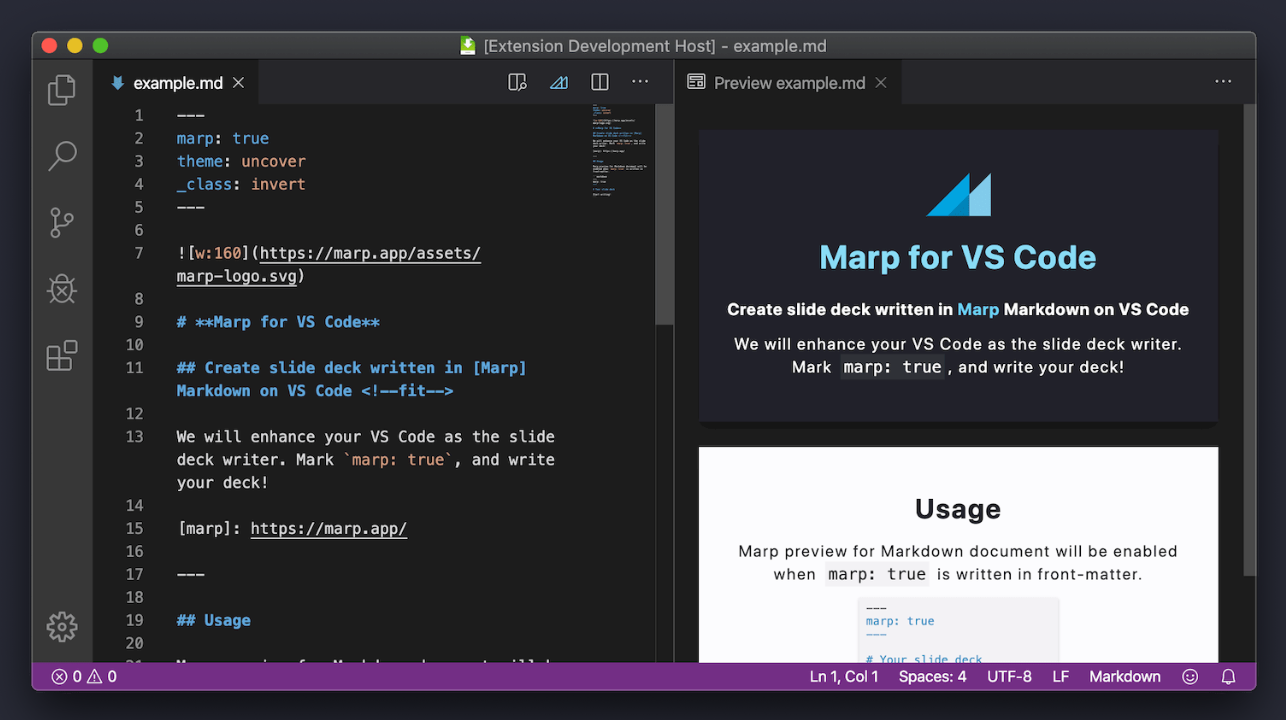MARP and VS Code: Supercharging Hypervelocity Engineering with Machine-Readable Presentations

Leveraging AI, hypervelocity engineering thrives on speed, structure, and clarity—especially when documentation and diagrams are straightforward, repeatable, and consumable by both people and machines. This post explores how MARP, combined with the VS Code MARP extension and MARP-CLI, enables engineering teams to turn Markdown into slide decks that are not only visually compelling but also machine-readable, supporting advanced workflows such as AI-driven code generation, quality assurance, and architectural analysis.

Why Use MARP for Presentations?
- Markdown-Based: Your slides are authored in Markdown—an open, text-based format—ensuring compatibility with version control, automation, and AI-powered analysis.
- Machine-Readable Documents: Markdown content can be processed as plain text, enabling parsing, search, and transformation beyond the capabilities of binary slides (e.g., PowerPoint).
- Seamless Integration: MARP integrates tightly with VS Code. The extension provides preview, directive IntelliSense, enhanced outline views, and direct export to formats like PDF or PPTX.
- CLI Automation: MARP-CLI makes it possible to batch-convert slides, run as part of DevOps pipelines, and ensure consistent output—even allowing conversion to editable PPTX for downstream collaboration with business stakeholders.
- Theme Control: Custom CSS lets teams standardize visual branding, while directives provide semantic control over individual slides.
Getting Started: Authoring Slides in VS Code
- Install the MARP VS Code Extension: Get the extension from the VS Code Marketplace, enabling real-time preview, directive autocompletion, and enhanced editing for Markdown presentations.
- Compose Slides in Markdown: Each slide is separated by a triple dash (
---). Use standard Markdown for headings, lists, code snippets, and images. Integrate draw.io diagrams via SVG or PNG links to maintain machine readability for architecture diagrams. - Use MARP Directives and IntelliSense: The extension highlights supported directives and assists with autocompletion, making it easy to define slide-level attributes and global settings. Examples include specifying themes, layout, or background images directly in your Markdown.
Preview and Editing: Accelerating Documentation Cycles
- Live Slide Preview: Edit Markdown with immediate feedback—with active slide highlighting and foldable outline views, making organization and navigation a breeze.
- Integrated Outline: Each slide appears in an outline view; this supports quick access and enhances editing in larger presentations.
- Diagnostics: The extension detects common issues and warns about unsupported directives, ensuring best practices.
Exporting Your Slides: Automation and Collaboration
- Quick Export Commands: Use the sidebar or VS Code command palette to export to PDF, HTML, PPTX, or image formats, suitable for sharing or further editing.
- Command-Line Power with MARP-CLI: Integrate
marp-cliin your CI/CD pipeline to automate slide deck conversion, batch export, and enforcement of branding or structure. Example CLI usage for batch conversion and parallelism:
marp --parallel --output dist my-deck.mdFor collaborative editing in PowerPoint, use the experimental --pptx-editable to generate decks that can be modified by stakeholders.
- Custom Themes: Register custom CSS for company branding. Edits to CSS automatically reload in the Markdown preview, streamlining visual updates.
Converting Markdown Presentations
MARP-CLI makes it simple to convert Markdown presentations to both PDF and PowerPoint (PPTX) formats for easy sharing and collaboration. By using straightforward CLI commands, a Markdown file can be transformed into a polished PDF or a portable PowerPoint deck. For example:
- To export to PDF:
marp slide-deck.md --pdf- To export to PowerPoint:
marp slide-deck.md --pptxThis export capability means that presentations authored in Markdown can seamlessly be distributed in the formats most stakeholders need—enabling streamlined review, handoff, and dissemination alongside the benefits of machine-readable source content.
Making Architectures and Documentation Machine-Readable
- Embedding Structured Diagrams: Link draw.io exported diagrams in Markdown so they remain accessible to automation tools. SVG format is ideal for machine parsing.
- Structured Content for AI: Write structured sections and code samples; AI tools can ingest, summarize, or generate code/comments based on Markdown, fostering hypervelocity development workflows.
- CI/CD Integration: With both MARP-CLI and Markdown, teams can automate documentation review, generate presentation PDFs for sprint reviews, and enforce structure—all from source control.
Key Benefits for Hypervelocity Engineering Teams
- Consistency: Markdown source ensures consistent structure, easy diffing, and reproducibility.
- Automation-Ready: Slides can be generated, validated, and enriched by AI, significantly reducing manual effort.
- Collaboration: Export to editable PPTX for business-side input but retain Markdown for engineering workflows.
- Traceability: Changes are tracked (version control); diagrams and docs are always up to date with code.
Closing Thoughts
By combining MARP with VS Code and MARP-CLI, engineering organizations unlock powerful workflows for AI-driven development, architectural communication, and machine-readable documentation—maximizing speed, transparency, and productivity in complex software projects.
Resources
- https://marketplace.visualstudio.com/items?itemName=marp-team.marp-vscode
- https://github.com/marp-team/marp-cli/releases
- https://marp.app
- https://github.com/marp-team/marp-cli
- https://github.com/marp-team/marp-cli/issues/298
- https://marketplace.visualstudio.com/items?itemName=marp-team.marp-vscode
- https://dashingelephant.xyz/blog/2022-02-01-presentations-as-code
- https://dev.to/rprabhu/marp-a-markdown-presentation-app-that-simplifies-your-tech-talks-37m4
- https://www.liatrio.com/resources/blog/codifying-presentations-deckset-and-marp
- https://git.hs-mittweida.de/marp/marp-template-hsmw/-/tree/main
